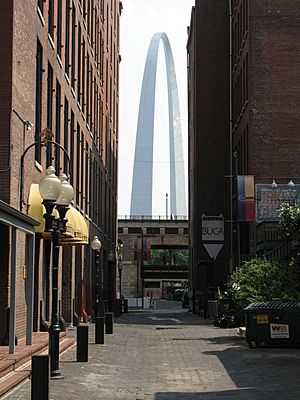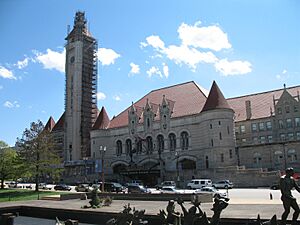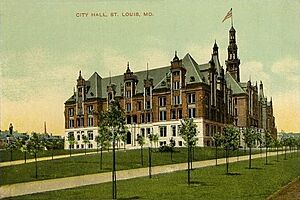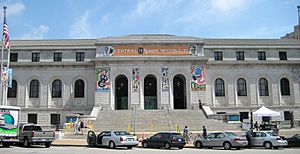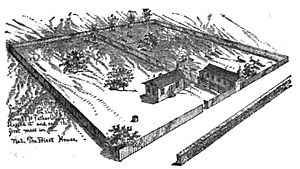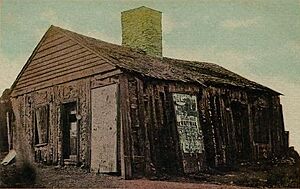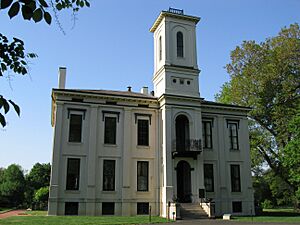Architecture of St facts for kids
St. Louis is a city famous for its amazing buildings! The architecture of St. Louis shows off many different styles. You can see everything from old homes and businesses to huge monuments. The most famous landmark is the Gateway Arch. It's the tallest monument in the entire United States! The city's buildings have been shaped by many cultures. You'll find styles like French Colonial, German, early American, Victorian, and modern designs.
Contents
Tall Buildings in St. Louis
St. Louis was one of the first cities to build many skyscrapers. This happened in the late 1800s. Two important early skyscrapers were designed by Louis Sullivan.
Early Skyscrapers and Famous Designs
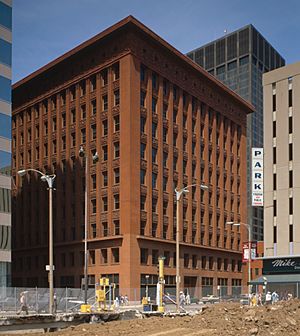
The Wainwright Building (built in 1891) is one of Sullivan's famous works. It has a strong base and a tall, vertical design. Another building, the Union Trust Building (1893), also showed his unique style.
Other tall buildings from this time include the Railway Exchange Building (1913). Some old factory buildings have been turned into cool places. For example, the International Shoe factory is now the City Museum. Sadly, some important buildings like the St. Louis Century Building were torn down.
Midtown's Theaters and Towers
In Midtown St. Louis, many theaters and tall office buildings were built. This happened between the Central West End and downtown. The Continental Life Building (1929) is a good example of Gothic Revival style.
The Fox Theatre (1929) is a grand Neo-Renaissance building. It was once a huge movie palace, seating over 5,000 people! Today, it's a popular place for live shows. Another Midtown building is the Powell Symphony Hall (1925). It used to be a movie and vaudeville theater. Now, it's home to the St. Louis Symphony.
Modern Skyscrapers Downtown
In the 1970s and 1980s, new modern skyscrapers appeared downtown. These include the One US Bank Plaza (1976) and the AT&T Center (1986). The One Metropolitan Square (1989) is the tallest building in St. Louis.
One US Bank Plaza is the local office for US Bancorp. It was built in a style that shows off its steel structure.
Newer High-Rise Buildings
In the 1990s, St. Louis built the largest courthouse in the United States. It's called the Thomas F. Eagleton United States Courthouse (finished in 2000). This courthouse is home to important federal courts. More recently, two new residential towers were built. These are the Park East Tower and the Roberts Tower.
Famous Landmarks and Monuments
St. Louis has many important buildings that tell its history. These include old churches and government buildings.
Early Religious and Civic Buildings
Some religious buildings from before the Civil War still stand. The Basilica of St. Louis, King of France (also called the Old Cathedral) was built from 1831 to 1834. It's in the Federal style. Other old churches include SS. Cyril and Methodius Church (1857) and Christ Church Cathedral (1867).
Early government buildings were also important. The first St. Louis courthouse was built in 1826. It had a Federal style stone front. This was later replaced by the Old St. Louis County Courthouse (finished in 1864). This building was special for its early cast iron dome. It was the tallest building in Missouri until 1894.
Riverfront History and Modern Icons
Many old buildings along the riverfront were torn down to build the Gateway Arch. But some parts of the city's past remain. Laclede's Landing is a district with cobblestone streets and old warehouses. It's now popular for its restaurants and clubs. Parts of the Anheuser-Busch Brewery also date back to the 1860s.
St. Louis built many more religious buildings in the late 1800s and early 1900s. The biggest and most beautiful is the Cathedral Basilica of St. Louis. It was built between 1907 and 1914. This Cathedral has one of the largest mosaic collections in the world! Another landmark is the St. Stanislaus Kostka, showing the Polish Cathedral style.
Around the time of the 1904 World's Fair, many churches moved to the Central West End. This area is near Forest Park. It includes the Holy Corners Historic District, with many historic religious buildings.
By 1900, St. Louis was the fourth largest city in the U.S. In 1904, it hosted the Louisiana Purchase Exposition (World's Fair) in Forest Park. The fair left behind some cultural buildings. These include the Saint Louis Art Museum and parts of the St. Louis Zoo. The Missouri History Museum was built later with money from the fair.
Later Civic Buildings and Modern Designs
After the Civil War, St. Louis quickly improved its schools and hospitals. The St. Louis Insane Asylum (now the Metropolitan St. Louis Psychiatric Center) is one of the oldest hospital buildings. It has a dome like the Old Courthouse.
St. Louis City Hall moved to its current spot in 1904. It was designed in the Renaissance Revival style. It looks a bit like the famous Hôtel de Ville in Paris, France.
Other important civic buildings include the U.S. Customhouse and Post Office (1873) and the grand St. Louis Public Library (1912). In 1923, the city decided to redevelop the Civic Plaza. This led to major buildings like the Soldiers' Memorial, the Civil Courts Building, and Kiel Auditorium.
In the mid-1900s, St. Louis developed its own modern style. Buildings like the Planetarium, the Climatron, and the main terminal at Lambert-St. Louis International Airport were built. The Poplar Street Bridge (1967) is a long bridge that carries several major highways. The most famous modern building is Eero Saarinen's amazing stainless-steel Gateway Arch. It's the center of the Jefferson National Expansion Memorial.
Homes and Houses in St. Louis
The very first homes in St. Louis were built in the French Colonial style. Even though Spain took control of the area in 1764, St. Louis remained a French settlement for a long time.
Early French and American Homes
Early St. Louis homes had three main French styles. The most common was the vertical-log house. These homes had walls made of upright wooden beams. Their roofs were made of thatch or wood shingles. Most homes in the late 1700s were built this way.
The second type was a frame house. These were built with a wood frame on a strong foundation. The third style was a rock house. Only the richest people could afford homes made entirely of rock. The first house in St. Louis, owned by Pierre Laclede, was a rock house.
The first American homes in St. Louis were simple log cabins. Rural homes were often small, with one or two rooms. Some larger rural homes were built in the I-house style. Many of these rural homes were later torn down as the city grew.
Country and City House Styles
More developed rural homes often showed the Federal Style. They had simple, balanced fronts with shuttered windows. Only a few of these homes, like the Lewis Bissell House (1830), still exist.
Other rural styles included Greek Revival, Italianate, and Gothic Revival. The Chatillon-DeMenil House (1849) was first Federal style, then rebuilt in Greek Revival. The Tower Grove House (1849) is a notable Italianate home. It was built in Henry Shaw's garden, which later became the Missouri Botanical Garden.
German immigrants also influenced St. Louis architecture. They brought the fachwerk construction method. These homes used timber frames. German immigrants also built stone houses, and some can still be seen in the Carondelet neighborhood.
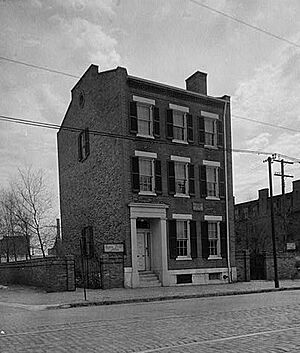
Most city homes were townhouses. They were similar to country homes of the same period. Styles included Greek Revival, Federal, and Italianate. Many homes blended these styles. The Joseph Campbell House (1851) is a museum today. The Henry Shaw City House (1851) was a mix of Federal and Italianate styles. One of the oldest townhouses is the Eugene Field House (1829).
Simpler urban house designs also appeared before the Civil War. These include shotgun houses and flounder houses. St. Louis has many flounder houses, which are narrow homes with a sloped roof. In crowded working-class areas, tenement houses faced the street, while flounder houses faced an alley.
Victorian and Modern Homes
St. Louis's homes grew a lot in the late 1800s and early 1900s. Many Victorian homes, including Second Empire style homes, can be found in Lafayette Square. St. Louis became known for its "private places." These were neighborhoods with large mansions and shared facilities like streets and gardens. Many of these private areas are still well-preserved today.
Styles in these private places include Chateauesque, Beaux-Arts, and Tudor Revival. In areas further west, homes show the influence of the Arts and Crafts Movement and the Prairie style.
After World War I, many new homes were built in the Colonial Revival style. These homes have traditional brick, dormers, and a balanced look. Many working-class homes in the 1920s and 1930s were bungalows. These can be seen all over south St. Louis. At the same time, more apartment buildings were built west of downtown.
Some of the most luxurious homes of the 1920s and 1930s were apartments and hotels. The Central West End neighborhood has examples like the Chase Park Plaza Hotel (1931), built in the Art Deco style.
Urban Changes and Preservation
After the 1950s, people started moving to the suburbs. This reduced the number of businesses and homes in the city. Nearby Clayton, Missouri also started building tall buildings. Clayton became another place for businesses to build offices.
Some city projects tried to clear old, low-income areas for new housing. One project was Cochran Gardens (1953). Another was the Pruitt–Igoe project, which built 33 tall towers. However, these projects became run-down and were eventually torn down in the 1970s and 2000s.
In recent years, groups like the Landmarks Association of St. Louis work to save historic buildings. The Cultural Resource Office also keeps a list of St. Louis city landmarks.
Images for kids
-
St. Louis Union Station Grand Hall
-
The Gateway Arch from the mall
-
City House in Grand Center, Second Empire style townhouse
-
The old Grand Avenue Water Tower, 1871


